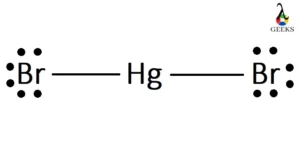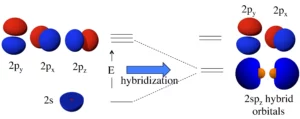HgBr2 or mercury bromide is a solid white coloured inorganic compound. Let us discuss the lewis structure and some properties of HgBr2 briefly.
HgBr2 has a linear structure with a molecular mass 340.41 g/mol. It is prepared by the reaction between metallic mercury and bromine. It is used as a reagent of Koenigs-Knorr reaction which forms glycosidic linkage in carbohydrates. It is a solid compound with density 6.03 g/cm3 and rhombic crystal structure.
Let us focus on the lewis structure, hybridization, bond angle, solubility, polarity and many more relevant topics on HgBr2.
How to draw HgBr2 lewis structure?
Lewis structure, a simplified structural representation of any molecule, shows nonbonding electrons around the atoms. Let us draw the lewis structure of HgBr2.
Assigning the valence electrons:
Hg is a d-block element having 2 electrons in its valence shell. Being a halogen atom, Br has seven valence shell electrons.
Determining the number of bonding electrons:
Hg is attached through two covalent bonds with the two Br atoms. Therefore, (2×2) = 4 electrons are participating as bonding electrons.
Finding out the nonbonding electrons:
Hg has no nonbonding electrons but each of the Br atom has six valence electrons which are shown around the Br atom in the below image.

HgBr2 Lewis Structure Shape
Lewis structure shape gives a clear idea on the three-dimensional atomic arrangement of the atoms in a molecule. Let us find out the shape of HgBr2.
The shape of HgBr2 is linear and the crystal of this compound possesses a rhombic structure. The linear shape of this molecule can be detected from the VSEPR (Valence Shell Electron Repulsion) theory.
Since the central atom, Hg has no nonbonding electrons in it, there is no interference of lone pair-lone pair and lone pair-bond pair repulsion in its ideal structure (detected from hybridization) and the actual structure or experimentally detected shape cannot be deviated from its ideal shape.
HgBr2 Lewis Structure Formal Charge
Formal charge is the theoretical charge assigned to an atom in a covalent molecule assuming that electrons are shared equally between the atoms. Let us explore it.
Formal charge calculation is not possible for HgBr2 as it is an ionic compound. In HgBr2, Hg is in +2 oxidation state and each of the Br is in -1 oxidation state but the concept of oxidation state is totally different from the concept of formal charge.
Formal charge cannot be calculated for any covalent compound because there is no such bond in which electrons are shared from both the side of the two atoms. Thus, no such bonding electrons exist in HgBr2.
HgBr2 Lewis Structure Angle
Lewis structure angle or bond angle is that angle generated between two bonds and one atom (central atom). Let us find out the bond angle in HgBr2.
The bond angle of HgBr2 is 1800 because of its linear structure. Hg and two Br atoms align in a straight line in HgBr2 and form a straight angle. Sp hybridizationof the central atom makes this molecule linear.
HgBr2 Lewis Structure Octet Rule
Octet rule is a rule which states that the main group elements form a bond in such a way that each atom achieves eight electrons in their valence shell. Let us discuss it.
The lewis structure of HgBr2 does not satisfy the octet rule as this rule is not satisfied by the central atom. mercury (Hg). It has two electrons in its outer most shell and even after forming two bonds with Br atom, it cannot achieve eight electrons in its valence shell.
But the substituent bromine atom obeys the octet rule. It has seven electrons in its valence shell (4s2 4p5) and when it forms sigma bond with the central atom, it gains another electron from Hg. Therefore, total number of valence electrons become eight for each of the Br atom which resembles with its nearest noble gas, krypton (Kr).
HgBr2 Lewis Structure Lone Pairs
Lone pairs or nonbonding electrons one type of valence electrons which are not shared with the substituent atoms in the time of bond formation. Let us discuss it in detail.
HgBr2 has total twelve nonbonding electrons or six lone pairs. All these nonbonding electrons belong to the Br atom which is calculated by this formula = (Total number of electrons in valence shell – number of bonding electrons).
- Nonbonding electrons of Hg = 2 – 2 = 0
- Nonbonding electrons of each of the Br atom = 7 – 1 = 6
- Therefore, total number of lone pairs in HgBr2 = 6 or 12 nonbonding electrons.
HgBr2 Valence Electrons
Valence electrons indicate the outer most shell electrons which are involved in bond formation due to having high reactivity. Let us find out it.
HgBr2 has total sixteen valence electrons. These valence electrons are calculated by the summation of the valence electrons of Hg and two Br atoms. Hg has two and each of the Br atom has seven electrons in their outer most shell.
Hg is a d-block element having valence shell electron configuration 5d10 6s2. These two electrons in 6s orbital are considered as valence electrons. Br is a halogen atom which belongs to the p-block of the periodic table and possesses valence shell electron configuration 5s2 5p5. Therefore, total valence electrons in HgBr2 are {2 + (7×2)} = 16.
HgBr2 Hybridization
Orbital hybridization is the concept of mixing of atomic orbitals having similar energy but different shapes to explain the chemical bonding in chemistry. Let us discuss it in detail.
The hybridization of HgBr2 is sp. One s and one p orbital of Hg participate in sp hybridization with two Br atoms. This sp hybridization directs the shape and bond angle of HgBr2 to be linear and 1800 respectively.

Image Credit: Wikimedia Commons.
HgBr2 Solubility
Solubility of a molecule depends upon that molecule and the solvent because for being soluble in a solvent both of them should have similar nature. Let us explain it.
HgBr2 becomes soluble in the following solvent-
- Water (solubility in water is 22g/100 ml at 250C).
- Hydrochloric acid (HCl)
- Ether
- Ethanol (solubility 30 g/100 ml at 250C)
- Chloroform
HgBr2 is dissolved basically in polar solvent because it is a polar molecule and polar molecules will always get dissolved in polar solvents. Polar solvents have positive and negative end and the positive end of HgBr2 is attracted by the negative end whereas negative end of HgBr2 is attracted by the positive end of polar solvents. In this way HgBr2 becomes soluble in the above solvents.
Is HgBr2 solid or gas?
Solid, liquid or gaseous state depends upon the extent of intermolecular forces of attraction present in the molecule. Let us discuss it in detail.
HgBr2 is a white crystalline solid laboratory reagent. The structure of its crystal is orthorhombic. It is solid because of its close packed crystal structure. There is a higher force of attraction present between the HgBr2 molecules due to this close packing.
To get the liquid state of HgBr2, a huge amount of heat energy should be provided to break the close packing. Therefore, it has a very high melting and boiling point, 2370 C and 3220 C respectively.
Is HgBr2 polar or nonpolar?
The factor polarity or non-polarity depends upon the relative arrangement of the bonds and the electronegativity difference between the atoms. Let us comment on this.
HgBr2 is all over a nonpolar molecule due to its linear structure. One bond dipole of Hg-Br bond is cancelled out by another Hg-Br bond. Therefore, instead of having electronegativity difference between Hg and Br, it becomes a nonpolar molecule with zero dipole moment.
Is HgBr2 acidic or basic?
Lewis acidity or basicity is the ability of accepting or donating electron pairs depending upon the population of valence shell of the atoms. Let us clarify it.
HgBr2 behaves as a lewis acid as it has the ability to accommodate electron pairs in the vacant orbital of Hg due to its+2 oxidation state and completely vacant valence orbital. One of its acid-base reaction is HgBr2 + 2Br– ⇌ HgBr4–, which proves that HgBr2 is definitely a lewis acid.
Is HgBr2 ionic or covalent?
Ionic or covalent character of a molecule depends on the bond formation whether they are formed by sharing of electrons or complete transferring of electrons. Let us explore it.
HgBr2 is an ionic compound. In HgBr2, Hg donates its two valence electrons to the Br atoms and becomes Hg2+ and Br becomes Br–. Therefore, the Hg-Br bonds are formed by electrostatic interaction through the complete sharing of electron pairs from less electronegative atom (Hg) to more electronegative atom (Br).
Is HgBr2 electrolyte?
Electrolytes are those who can generate two distinct positive and negative ions in aqueous or solvated condition. Let us comment on whether HgBr2 is electrolyte or not.
HgBr2 is definitely an electrolyte because it is an ionic compound and ionic compounds become electrolyte as they can be dissociated into two ions in aqueous solution (HgBr2 ⇌ Hg2+ + 2Br–). Therefore, they can conduct electricity and it shows maximum conductivity at about 4600 C.
Conclusion
HgBr2 is used in the test for the identification of arsenic. It reacts with indium vigorously at high temperature. It is a not so nature friendly chemical compound like all other mercury salts.
Also Read:
- Sibr4 lewis structure
- Gah3 lewis structure
- Cs lewis structure
- Pf5 lewis structure
- Ch3o lewis structure
- Bf3 lewis structure
- Obr2 lewis structure
- Cli3 lewis structure
- Ocs lewis structure
- Ascl5 lewis structure

Hello,
I am Aditi Ray, a chemistry SME on this platform. I have completed graduation in Chemistry from the University of Calcutta and post graduation from Techno India University with a specialization in Inorganic Chemistry. I am very happy to be a part of the Lambdageeks family and I would like to explain the subject in a simplistic way.
Let’s connect through LinkedIn-https://www.linkedin.com/in/aditi-ray-a7a946202